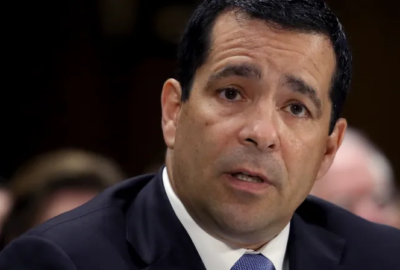
OPM details core values behind coming security clearance reforms with new policy doctrine
With the publication of a new federal personnel vetting core doctrine, the Trump administration has outlined the basic principles and core values that will guide...
In ongoing efforts to modernize a decades-old suitability, credentialing and security clearance processes, the Trump administration has published a new “doctrine” that describes the core values and philosophies that will guide its work.
The federal personnel vetting core doctrine, scheduled for publication Wednesday, comes from the Office of the Personnel Management and the agency’s acting director, who serves as the government’s suitability and credentialing executive agent.
The doctrine outlines the principles and philosophies that guide the administration’s Trusted Workforce 2.0 initiative, which first began as an effort to resolve a sky-high security clearance backlog and has since evolved to overhaul a decades-old, governmentwide personnel vetting system.
Today, the security clearance inventory sits at roughly 213,000, according to a recent update from the administration on Performance.gov. The ongoing pandemic has delayed bits and pieces of the Defense Counterintelligence and Security Agency’s ability to perform background investigations, but the inventory remains well within reach.
With the inventory under control, the Trump administration has turned its efforts to modernization, and the new personnel vetting doctrine defines the principles, processes and policy priorities needed to advance those goals.
The administration has teased the publication of a federal personnel vetting doctrine for some time now. Defense and intelligence officials leading the personnel vetting modernization efforts previously said the administration had prepared three policy directives that would help kick-start the Trusted Workforce 2.0 initiative.
The doctrine was among the three policy directives planned more than a year ago, as Federal News Network previously reported.
Other policy directives instructed agencies to embrace continuing evaluation and vetting, and encouraged them to begin using automated records checks on their clearance holders if they weren’t already.
But the doctrine serves as a kind of guidebook for agencies on the administration’s planned efforts to reimagine the way they think about establishing trust with members of the federal workforce.
“The federal government must effectively optimize the resources, information and technology to support the goal of a trusted workforce to conduct the business of the federal government,” the doctrine reads. “Personnel vetting assesses the trustworthiness of individuals based on the core characteristics to protect people, property, information and mission, as they relate to the particular purpose.”
The suitability and security agents will review the personnel vetting doctrine every five years, and individual agencies should periodically review their own policies to ensure they comply with federal goals as well, OPM said.
“The next steps involve consulting with federal agencies through interagency processes to refine and begin issuing and implementing the policies across the federal government to bring about change,” OPM wrote. “In the coming months, ODNI and OPM anticipate several executive branch policies to be issued that will provide high-level direction, establish an aggressive path forward and outline immediate steps to bridge to the future state.”
For OPM, the “future state” produces a “trusted workforce” based on “conduct, integrity, judgment, loyalty and reliability,” the doctrine reads.
A successful personnel vetting system produces timely investigations and trust determinations, the doctrine said, and inspires confidence from the public and the federal workforce itself.
Perhaps the most notable passage from the new doctrine describes a personnel vetting system that allows and promotes the mobility of a cleared individual between and within federal agencies and contractors, and allows employees to move in and out of the private sector and back again.
“Mobility is enhanced by efficient transfer of trust determinations and reciprocity between departments and agencies, and across roles for individuals who work for or on behalf of the federal government,” the doctrine reads.
This is a notable sea-change for the government, which hasn’t often allowed former federal employees to take their security clearances with them when they move to a new job in the private sector, or vice versa.
But industry groups have advocated the Trump administration should embrace this concept in recent years, as many agencies rely on the expertise of former federal executives and contractors to meet their missions but have been hindered by a slow investigative process that requires clearance holders to reapply for brand new credentials.
Embracing a more mobile workforce is possible when federal policy describes the characteristics of a “trusted” person and agencies apply those criteria consistently, resulting in “basic trust determinations that are uniform across all agencies,” OPM said.
Instead, OPM said agencies should apply organization or position-specific criteria on a relatively infrequent basis and only when necessary. Industry groups have said agencies have often struggled with the concept of “reciprocity,” where if one agency places trust and grants a security clearance to a federal employee or contractor, most other agencies — generally — will too.
A 2019 study from the Intelligence and National Security Alliance found widespread reciprocity delays across government, which could amount to some 90,000 lost contractor labor years.
The OPM doctrine goes on to detail the kinds of information that agencies should collect and use to make risk-based trust determinations for its employees and contractors.
The information agencies use to make trust and risk determinations about their employees and contractors should be accurate, relevant and timely, OPM said. The collection process shouldn’t be overly intrusive, and there should be safeguards in place to ensure the information is protected and used appropriately.
These details are especially relevant as agencies slowly ease away from the traditional periodic reinvestigation process and use a series of automated records checks to keep tabs on their clearance holders.
More than 2.3 million people, or roughly half of the cleared population, were enrolled in a continuous evaluation or vetting program as of November, DCSA said.
“Vetting practitioners are engaged with individuals during the entire vetting process to collect information, resolve derogatory information, improve transparency and cultivate effective two-way communication between the individual and the government,” the doctrine reads. “Trusted insiders and the government share responsibility for maintaining complete, accurate and relevant information as part of an individual’s personnel vetting record.”
Copyright © 2025 Federal News Network. All rights reserved. This website is not intended for users located within the European Economic Area.
Nicole Ogrysko is a reporter for Federal News Network focusing on the federal workforce and federal pay and benefits.
Follow @nogryskoWFED




